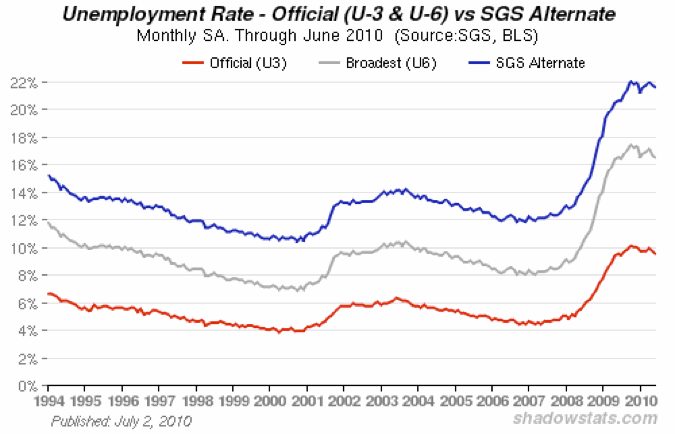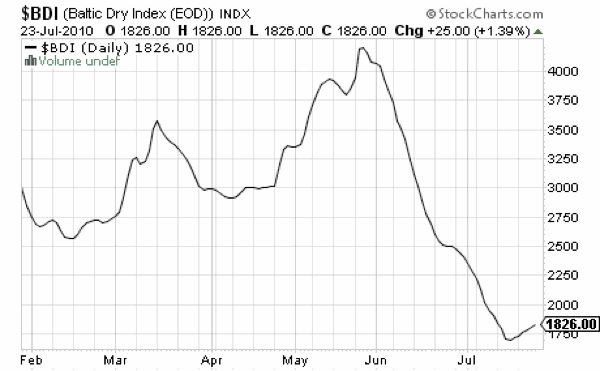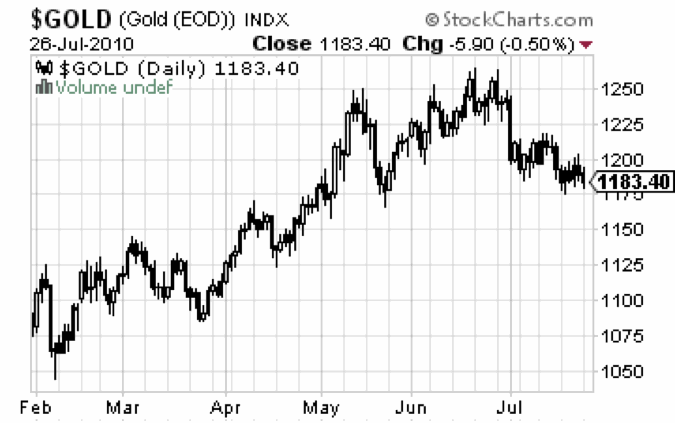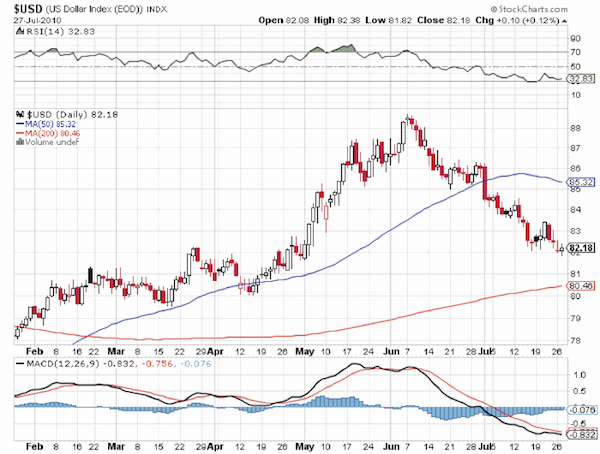Gold Promises and Currency Lies
Commodities / Gold and Silver 2010 Jul 29, 2010 - 11:11 AM GMTBy: Midas_Letter
 The signals emanating from the global economic matrix that can be considered realistic, unbiased and leading indicate strongly that we’re edging closer to another brink of some sort. Nobody can see over the edge, but if the last cataract shot by our collective connected market kayak is anything to go by, the Eskimo roll escape afforded by government counterfeiting (oops…I mean ‘stimulus’) is not likely to deliver us to any safe harbor.
The signals emanating from the global economic matrix that can be considered realistic, unbiased and leading indicate strongly that we’re edging closer to another brink of some sort. Nobody can see over the edge, but if the last cataract shot by our collective connected market kayak is anything to go by, the Eskimo roll escape afforded by government counterfeiting (oops…I mean ‘stimulus’) is not likely to deliver us to any safe harbor.
Here are my favorite indicators and what they're doing:
1. Unemployment statistics from ShadowStats.com:

The U.S. Department of Labor is shamelessly optimistic to a degree that would make George Orwell blush. Actually, optimistic is not the word…just plain misleading is the better descriptor. The official numbers in red versus the ShadowStats numbers as determined by that site’s John Williams, himself a professional consulting economist, demonstrate a discrepancy of at least 10%.
The macro-trend speaks for itself. The counterfeit dollars (I mean stimulus dollars) that have been directed exclusively to the same large financial institutions who perennially fleece the average Joe have done nothing to offset the carnage that the small business landscape has become. This single chart alone, even if it was the official numbers that were actually true, demonstrate clearly what should be headline news: No broad economic recovery is possible without employment. Dear mainstream financial press editors: Please quit seizing upon temporally insignificant anomalies within macro data and offering them up as evidence of recovery. Nobody believes you anyway.
2. Baltic Dry Index

The Baltic Dry Index is a relatively pure snapshot of the supply and demand for the global commodities that are transported around the world on ships. When the chart is rising, it indicates there are fewer ships competing for larger numbers of cargoes and when the chart falls it indicates that the competition for cargoes is high because there is less shipping demand. So when you see a prolonged period of sustained declines, such as that which we've witnessed since the end of May this year, it's a strong indication that there is a general deterioration in global economic activity, because the commodities shipped are essentially the building components of everything from roads to cars to industrial machinery. With a decrease of over 50% in just under three months, the Baltic Dry Index is suggesting that there is a huge lull in commodity movement, which in my view, is an excellent precursor to stagnation in global industrial output. No demand, no supply, no jobs, no money, no recovery.
3. Price of gold

It must be idiot season. A growing chorus of clowns on tiny mental tricycles have been clamoring since about May for a great gold sell-off. And as usual, it's the people with the most impressive credentials leading the lunacy. I'd list them here, but I prefer to stick to my mother's advice: If you don't have something nice to say about someone…..
Gold's recent price weakness is a harbinger of many things. It tells us that the sell-off that always occurs after setting a new record, part of a standard pattern over the last ten years, is again underway. If we analyze that trading pattern with an eye towards future price movement potential, this solid foundation in the $1150 to $1200 range would suggest that there should soon be another price record run coming up soon.
Absent the meaningful fiat currency management changes that would have to be adopted by the G8, namely a broad cessation of the unbridled counterfeiting (oops…I mean "stimulus"), there is no reason for gold's advance to cease.
The problem with so much counterfeit money in the system is that it can be brought to bear on markets that would otherwise reflect cleanly the pure influence of supply and demand – that is, supply created from primary sources and demand created from use. Not the artificial supply and demand created by "investment" and "stockpiling" and "derivatives" that make it so hard to see the unadorned truth. At some point in the future, the gambling instruments we call futures will be abolished, consigned to that growing heap of Ill-conceived Human Inventions. For now though, we must muddle through the mine-field as best we can, as lowly individual investors trying to preserve our wealth while perhaps adding to it.
Looking at the gold chart of the last six months, a technician may be forgiven for proclaiming an end to gold's bull market, but all it will take is a look at the ten year chart to see how naïve such a conclusion would be.

Lets face it: Stimulus is nothing more than perpetuating debt into a distant futures where there is no bank with a foreclosure stamp hovering over the ersatz value of our G8 economies. If I agree and he agrees and they agree that we all agree to pretend that this cycle of continuous counterfeiting (oops…I meant 'stimulus') is legitimate, then we can kite cheques back and forth among ourselves while fattening up on caviar and foie gras washed down with fabulous Malbecs and Syrahs in perpetuity. Our capacity for self-delusion is only exceeded by our passion for haute cuisine.
The question is, at what point does the unassailable reality overcome the artificiality of this manufactured supply and demand? Where does the buck actually stop these days? At this point, difficult to discern the future, it is. (as Yoda would say). The real demand is for a standard of living beyond reason and belief. Homes across the world, instant travel several times a week, wardrobes of overpriced clothing seldom worn twice…all part of a flawed perception that this ability to satisfy any desire at the drop of a hat is somehow representative of personal freedom and power. But I now digress into the metaphysical/philosophical, and so not wanting to risk the alienation of anyone who has read this far, I return to matters economic.
Down here in Perú, the economy grew by an astonishing 9.6% in the month of May. This is a legitimate figure. Perú is experiencing the unleashed entrepreneurial fury of a culture finally unburdened after 63 military dictatorships' suppression. You can now compete head to head with established family businesses without the concern that one of your son's ears will appear in your mailbox or the family patriarch will be machine-gunned down in his driveway. And the government's heretofore artificial public outrage directed at corruption has had the unanticipated side effect that its tougher for your assets to be swiped. Still, SUNAT, the equivalent of Canada's Revenue Agency or the IRA of the United States, can wedge you between a rock and a hard place should you earn their wrath for any reason. Now all the country needs is enforcement of laws and an improved appreciation for public hygiene and architectural beauty, and there is a chance this place could, as local culinary icon Gaston Acurio avers, be 'first world' within ten years. The biggest customer here for assets is China, buying everything from iron and copper to timber and shellfish farms.
By all accounts, China continues to be the only shoulder against the wheel of the economic engine with sufficient velocity and inertia to keep the thing turning at all. But that strength upon which we are all to some degree reliant presently may be faltering.
Earlier this month, former IMF chief economist Ken Rogoff said that China's property market was starting to collapse. He points out that the value of property sales dropped 25% in May from the previous month.
And after an 11.9% growth in GDP for the first quarter of 2010 over last year, the Chinese government has set itself a growth rate of 9.1%.
This diminished performance from the world's strongest economy does not bode well for the general future welfare of the global economic system. The alleged recovery underway, whose legitimacy is certainly a very large question mark, will most definitely be further undermined by even a slight deterioration in China's appetite for commodities. And judging by the Baltic Dry index, and the chart above, that slowdown is already underway.
4. US Dollar Index

This is ugly. After peaking in June, the index is headed back to the basement, which will only induce more printing with abandon counterfeiting which has become the U.S. government's particular brand of anesthetic to treat the pain from its gaping trade deficit wound. And, just like all anesthetics, they are effective at diminishing the pain, but do absolutely nothing to treat the actual wound. The purchasing power of the American people continues to deteriorate in lockstep with the average Joe on Main Street's opportunities to create revenue. If that's not a recipe for civil unrest, I don't know what is.
At this point, the old Jewish farewell that says, "May you live in interesting times" has taken on a whole new dimension, and in the months to come, interesting may become synonymous with fatal.
Is this the beginning of the wholesale abandonment of the U.S. Dollar? If so, there's a much bigger precipice ahead for all of us.
Want to subscribe to Jame's West's Midas Letter Premium Edition? Learn about the emerging resource sector stocks he's buying and selling each month for only US$39.00 per month. Click here to learn more..
By James West
James West writes the MidasLetter at MidasLetter.com where subscribers learn about emerging companies in the junior resource sector.
© 2010 Copyright Midas Letter - All Rights Reserved
Disclaimer: The above is a matter of opinion provided for general information purposes only and is not intended as investment advice. Information and analysis above are derived from sources and utilising methods believed to be reliable, but we cannot accept responsibility for any losses you may incur as a result of this analysis. Individuals should consult with their personal financial advisors.
Midas Letter Archive |
© 2005-2022 http://www.MarketOracle.co.uk - The Market Oracle is a FREE Daily Financial Markets Analysis & Forecasting online publication.



